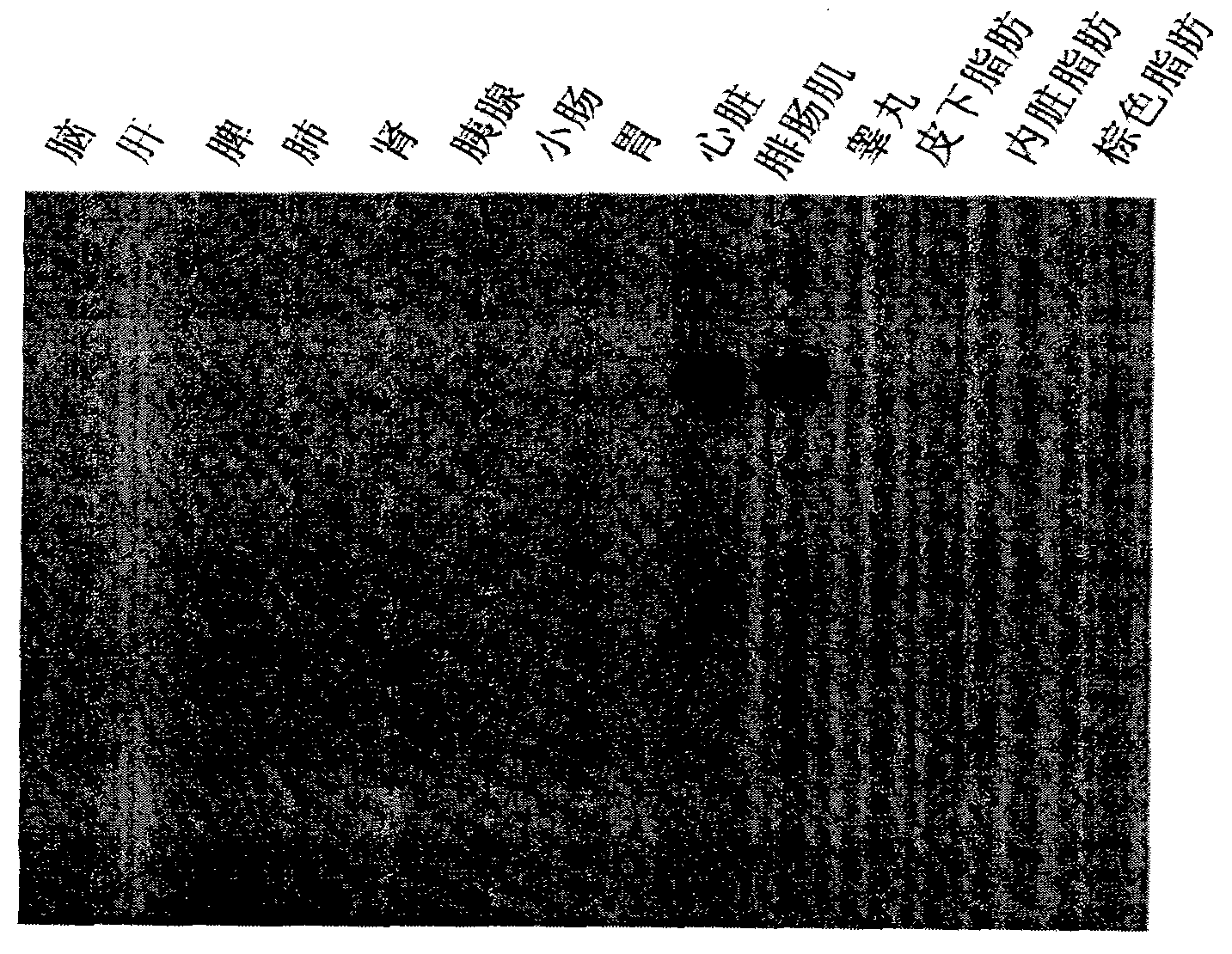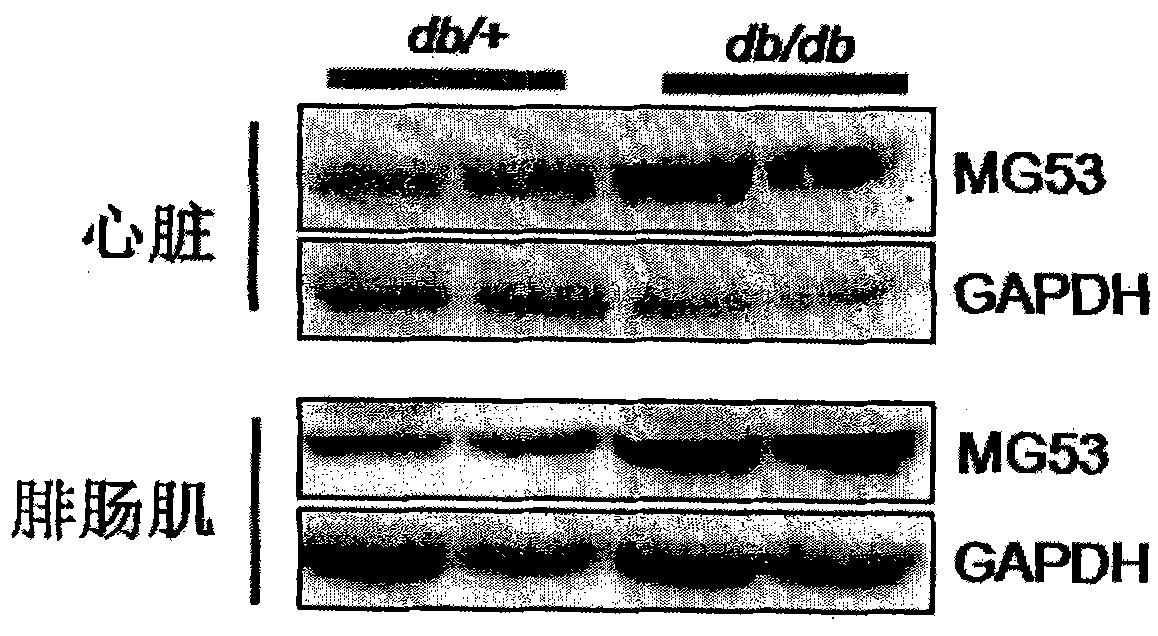Application of MG53 gene to treatment of insulin resistance, type II diabetes mellitus and related diseases thereof
A technology for insulin resistance and related diseases, used in gene therapy, metabolic diseases, cardiovascular system diseases, etc., can solve problems such as liver damage, aggravate heart burden, increase blood volume, etc., to promote glucose metabolism, inhibit obesity, and reduce adverse effects. effect of reaction
- Summary
- Abstract
- Description
- Claims
- Application Information
AI Technical Summary
Problems solved by technology
Method used
Image
Examples
Embodiment 2
[0058] Example 2 Overexpression of MG53 in adult rat cardiomyocytes inhibits insulin-mediated glucose uptake
[0059] (1) Overexpression of MG53 in adult rat cardiomyocytes
[0060] Take the heart of an 8-week-old male SD rat, separate the cells by enzymatic perfusion, plant the cells in a culture dish (10), and infect with 200 moi of GFP or GFP-MG53 adenovirus (Ad-GFP or Ad-GFP-MG53) for 48 hours , observe the transfection efficiency under a fluorescence microscope, and the cells infected with adenovirus can show fluorescence under a fluorescence microscope ( Figure 4 ). Protein was extracted for SDS-PAGE-immunoblotting test (Western blot) to detect the protein content of MG53 ( Figure 5 A), Determining the efficiency of MG53 overexpression ( Figure 5 B). Figure 4 and Figure 5 It shows that in Ad-GFP-MG53-infected rat cardiomyocytes, MG53 has been overexpressed (*: p<0.001 vs GFP group, the results of at least 6-8 experiments in each group).
[0061] (2) Detection ...
Embodiment 3
[0063] Example 3 Overexpression of MG53 in adult rat cardiomyocytes inhibits insulin receptor signal transduction
[0064] (1) The method for overexpressing MG53 in adult rat cardiomyocytes is the same as that described in (1) in Example 2.
[0065] (2) To detect the inhibition of insulin receptor signal transduction by overexpression of MG53 in adult rat cardiomyocytes overexpressing MG53.
[0066] Infect adult rat cardiomyocytes (10 5 cells / well) after 48 hours, use 10 -7 Insulin stimulation of M for 0 minutes, 5 minutes and 10 minutes, and then the cellular protein was extracted for SDS-PAGE-immunoblotting (Western blot), the results showed that overexpression of MG53 completely inhibited the activation of insulin-mediated downstream signals Akt and ERK ( Figure 7 ). Further, MG53 was overexpressed in differentiated C2C12 myotube cells [2% horse serum (Hyclone, USA) induced for 6 days], with 10 -7 After 10 minutes of insulin stimulation of M, Western blot was performed...
Embodiment 4M
[0067] Example 4 MG53 deficiency inhibits obesity induced by high-fat diet
[0068] C57 mice wild-type and MG53 knockout (see "Nature Cell Biology" for the preparation method of MG53 knockout mice, Cai et.al.2009; 11(1):56-64) were divided into normal diet group and high Two groups of fat diet group, 20 mice in each group. The normal group of C57 mouse wild type and MG53 knockout type were given normal growth and breeding feed (the feed was purchased from the Academy of Military Medical Sciences) from the age of 3 weeks; Feed (the feedstuff is purchased from Research Diets, USA), then measure the body weight of the mice every week, and draw the growth curve of the mice ( Figure 10 ). The results showed that for wild-type mice, the body weight increased significantly (from about 35g to about 55g) after being fed with a high-fat diet, while MG53 deficiency had no significant effect on the weight growth of mice under normal diet conditions, but high-fat diet Diet-induced obes...
PUM
 Login to View More
Login to View More Abstract
Description
Claims
Application Information
 Login to View More
Login to View More - R&D
- Intellectual Property
- Life Sciences
- Materials
- Tech Scout
- Unparalleled Data Quality
- Higher Quality Content
- 60% Fewer Hallucinations
Browse by: Latest US Patents, China's latest patents, Technical Efficacy Thesaurus, Application Domain, Technology Topic, Popular Technical Reports.
© 2025 PatSnap. All rights reserved.Legal|Privacy policy|Modern Slavery Act Transparency Statement|Sitemap|About US| Contact US: help@patsnap.com



